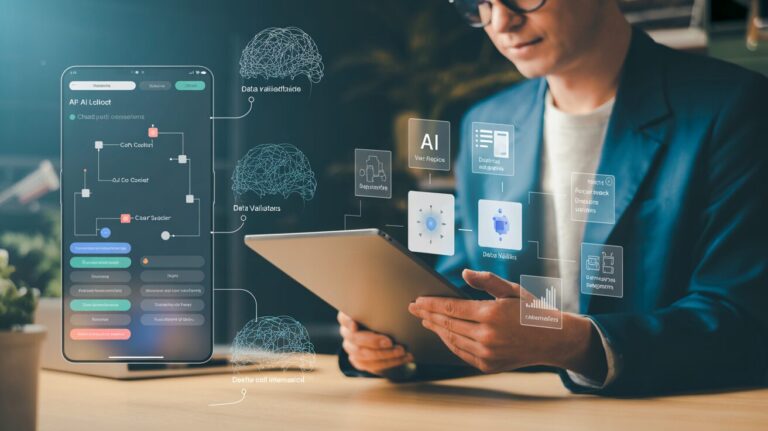Table Of Contents
The artificial intelligence revolution has unleashed unprecedented opportunities for creators, entrepreneurs, and businesses to develop innovative applications that solve real-world problems. As AI technologies become more accessible, a crucial question emerges for anyone venturing into this space: how can you monetize your AI application effectively?
Whether you’re a content creator looking to package your expertise into an AI advisor, a small business owner wanting to enhance customer service with a chatbot, or an educator developing interactive AI quizzes, understanding monetization strategies is essential for sustainable success.
This comprehensive guide will walk you through the fundamentals of AI app monetization, exploring various revenue models, implementation challenges, and best practices. We’ll also examine how no-code AI platforms are democratizing both the creation and monetization of AI applications, making this technology accessible to innovators regardless of their technical background.
AI App Monetization Guide
Strategies for generating revenue with AI applications
AI app monetization allows creators of all technical backgrounds to generate revenue from their artificial intelligence applications through various business models.
Subscription Models
Recurring payment model offering predictable revenue streams. Create tiered pricing (Basic, Pro, Enterprise) with different feature sets.
Freemium Strategy
Offer basic features free with premium upgrades. Lowers adoption barriers, generates usage data, and creates network effects to drive conversions.
Usage-Based Pricing
Charge based on consumption metrics like API calls or processing time. Scales with user needs and aligns costs with actual usage.
White-Labeling & Licensing
License your AI technology to other businesses. Expands reach through established partners and typically commands higher-value B2B contracts.
Best Practices for Successful Monetization
Focus on demonstrable ROI and quantifying the value your AI delivers
Create multiple monetization layers rather than relying on one approach
Implement gradual onboarding to let users experience value before payment
Monitor usage patterns to inform pricing tiers and feature bundling
No-Code Democratization
Platforms like Estha now enable anyone to create and monetize AI applications without coding knowledge, using intuitive interfaces and built-in monetization tools.
Lower Development Costs
Faster Time-to-Market
Broader Creator Base
Ready to start monetizing your AI application?
Understanding AI App Monetization
AI app monetization refers to the strategies and methods used to generate revenue from artificial intelligence applications. Unlike traditional software, AI apps often have unique characteristics that influence their monetization potential:
Ongoing operational costs: Many AI applications require continuous computing resources for model training, inference, and data processing. These recurring expenses necessitate sustainable revenue streams rather than one-off payments.
Value perception: Users typically value AI applications based on the quality of outputs, accuracy of predictions, or productivity gains rather than feature lists. This shifts the monetization focus toward value-based pricing models.
Data dependencies: AI systems often improve with more data and usage. This creates opportunities for monetization strategies that scale with user engagement and application effectiveness.
Specialized expertise: AI applications encapsulate domain knowledge and expertise that might otherwise require hiring specialists or consultants, creating unique value propositions that can command premium pricing.
Popular Monetization Models for AI Applications
The AI application landscape offers diverse monetization opportunities tailored to different user needs, business models, and value propositions. Let’s explore the most effective approaches:
Subscription-Based Models
Subscription models provide users access to AI applications for a recurring fee, typically billed monthly or annually. This approach offers several advantages:
Predictable revenue: Recurring subscriptions create a stable, predictable income stream that helps cover ongoing operational costs and future development.
Tiered pricing opportunities: You can create multiple subscription tiers (basic, professional, enterprise) with varying features, usage limits, or service levels to address different market segments with a single product.
Long-term relationships: Subscription models foster ongoing relationships with users, providing opportunities to demonstrate increasing value over time as AI models improve and new features are added.
For example, an AI writing assistant might offer a basic tier with limited word generation capabilities, while higher tiers unlock advanced features like tone adjustment, specialized content formats, or priority processing during peak usage times.
Freemium Models
The freemium approach provides basic functionality at no cost while charging for premium features. This model works particularly well for AI applications because it addresses the “try before you buy” hesitation many users have with AI tools.
Lower adoption barriers: Free access allows users to experience the application’s value without financial commitment, significantly widening your potential user base.
Data advantages: Free users contribute valuable usage data that can improve your AI models, benefiting all users while creating incentives for upgrade.
Network effects: Broad free adoption can create network effects where the value of the application increases as more users join, potentially accelerating paid conversions.
For instance, an AI-powered customer service chatbot might offer basic query handling capabilities for free, with premium tiers unlocking advanced features like sentiment analysis, personalization options, or integration with CRM systems.
Usage-Based Pricing
Usage-based models charge users based on their consumption of the AI service, typically measured by API calls, processing time, data volume, or specific actions. This approach aligns costs with actual usage and value received:
Scalability: Pricing automatically scales with user needs, removing barriers to adoption for smaller users while capturing appropriate value from power users.
Fair perception: Users generally perceive usage-based pricing as fair since they pay only for what they use, which can increase willingness to adopt new AI technologies.
Resource alignment: This model naturally aligns with the costs of running AI infrastructure, which typically scales with usage.
For example, a medical imaging AI that analyzes scans might charge per image analyzed, with volume discounts for healthcare providers who process larger quantities of images.
One-Time Purchases
While less common for cloud-based AI applications, one-time purchase models can work for specialized AI tools that operate locally or have defined functionality that doesn’t require ongoing updates:
Simplicity: One-time purchases offer straightforward transactions without recurring billing relationships.
Perceived ownership: Users may value the sense of ownership that comes with a purchase rather than a subscription, particularly for specialized tools.
Upfront revenue: This model generates immediate revenue, which can be valuable for funding development or business operations.
A specialized AI tool for financial analysis might sell as a one-time purchase with optional paid upgrades for new versions with expanded capabilities.
White-Labeling and Licensing
For developers with powerful AI applications, white-labeling and licensing can provide B2B revenue streams:
Expanded reach: Your technology can reach markets and industries through established partners who already have customer relationships.
Higher-value contracts: B2B licensing deals typically involve higher price points than direct-to-consumer sales.
Reduced marketing costs: Partners take on the marketing and customer acquisition costs while you focus on technology development.
For instance, an AI content moderation system might license its technology to social media platforms or community forum software rather than targeting end users directly.
How to Choose the Right Monetization Strategy
Selecting the appropriate monetization approach depends on several factors specific to your AI application and target audience:
Understand your value proposition: Identify the specific problem your AI application solves and how much that solution is worth to your target users. Premium pricing works for applications delivering significant value (cost savings, revenue generation, or solving critical problems).
Analyze your costs: Calculate your development, hosting, and operational expenses, including AI model training and inference costs. Your pricing must sustainably cover these expenses while delivering appropriate profit margins.
Know your audience: Different user segments have varying willingness to pay and preferred payment models. Consumer applications might benefit from freemium approaches, while enterprise solutions often work better with subscription or usage-based pricing.
Consider competitive positioning: Analyze how comparable AI solutions are priced and positioned. Your strategy might involve premium pricing for superior quality or more competitive pricing to gain market share.
Evaluate long-term goals: Consider whether your priority is rapid user acquisition, maximum revenue per user, or creating network effects. Your monetization strategy should align with these broader business objectives.
Challenges in AI App Monetization
Monetizing AI applications comes with unique challenges that developers should prepare for:
Demonstrating value: Users may be skeptical about AI capabilities or struggle to understand the technology’s value before using it. This makes free trials, transparent demonstrations, and clear case studies crucial for conversion.
Managing computing costs: AI applications often have significant computational requirements that can scale unpredictably with usage. Your monetization strategy must account for these variable costs to maintain profitability.
Balancing accessibility with profitability: Setting prices too high limits adoption, while pricing too low may create unsustainable operations. Finding this balance often requires experimentation and careful market analysis.
Competing with free alternatives: Many basic AI functionalities are available through free services. Your monetization strategy must clearly articulate why your solution justifies payment compared to these alternatives.
Addressing privacy concerns: Users may have concerns about how their data is used in AI applications. Clear privacy policies and data usage transparency are essential for building the trust necessary for monetization.
AI App Monetization Best Practices
Implementing these best practices can help maximize the revenue potential of your AI application:
Focus on demonstrable ROI: Clearly articulate and quantify the return on investment your AI application delivers. Concrete examples of time saved, revenue generated, or costs reduced are powerful conversion drivers.
Create multiple monetization layers: Combine complementary revenue streams rather than relying on a single approach. For example, offer a freemium product with subscription tiers and additional usage-based charges for high-volume users.
Use value-based pricing: Price based on the value delivered rather than just covering costs. If your AI application saves users thousands of dollars, pricing should reflect a fair portion of that value creation.
Implement gradual onboarding: Design a path that allows users to experience value before committing to payment. This might include limited free functionality, trial periods, or demonstrations with sample data.
Monitor and analyze usage patterns: Track how users interact with your application to identify features they value most. This data can inform pricing tiers, feature bundling, and product development priorities.
Democratizing AI App Creation and Monetization
Historically, AI application development required substantial technical expertise in machine learning, programming, and infrastructure management. This limited AI monetization opportunities to those with specialized technical backgrounds.
The emergence of no-code AI platforms has fundamentally changed this landscape. Platforms like Estha now enable anyone to create custom AI applications without coding or prompting knowledge. This democratization has several implications for AI app monetization:
Broader creator base: Subject matter experts across industries can now create and monetize AI applications based on their domain knowledge rather than technical skills.
Lower development costs: No-code platforms significantly reduce the time and resources required to develop AI applications, improving profit margins and reducing financial risk.
Faster time-to-market: Applications that might have taken months to develop can now be created in minutes or hours, allowing creators to quickly test monetization approaches and iterate based on market feedback.
Integrated monetization tools: Leading no-code platforms often include built-in monetization features that simplify implementing subscription models, usage tracking, or payment processing.
For example, a therapist with expertise in mental health but no programming knowledge can use Estha’s drag-drop-link interface to create an AI-powered therapeutic assistant that provides personalized support to clients. The therapist can then monetize this application using Estha’s integrated tools to offer subscription tiers or session-based pricing.
Future Trends in AI App Monetization
The AI app monetization landscape continues to evolve. Here are emerging trends to watch:
Outcome-based pricing: As AI applications deliver increasingly measurable results, pricing models that charge based on specific outcomes (successful transactions, qualified leads generated, problems solved) will become more common.
AI marketplaces: Specialized marketplaces for AI applications will expand, offering creators new distribution channels with built-in monetization infrastructure and access to targeted audiences.
Micro-subscriptions and granular access: More flexible subscription models with shorter durations or access to specific capabilities will emerge, allowing users to pay only for exactly what they need when they need it.
Decentralized AI economies: Blockchain and token-based systems will enable new monetization models where users can contribute data or computing resources in exchange for access to AI capabilities.
Embedded AI monetization: AI capabilities increasingly will be monetized as components embedded within larger products and services rather than as standalone applications.
Conclusion
AI app monetization represents a significant opportunity for creators, entrepreneurs, and businesses across industries. By understanding the unique characteristics of AI applications and implementing appropriate monetization strategies, you can build sustainable revenue streams around your artificial intelligence innovations.
The democratization of AI development through no-code platforms has opened these opportunities to a much broader audience, allowing domain experts to create and monetize AI applications without technical barriers.
As you embark on your AI app monetization journey, remember that successful monetization requires a balance between capturing fair value and delivering exceptional user experiences. Start with a clear understanding of your target audience’s needs, communicate your value proposition effectively, and be willing to experiment with different pricing and packaging approaches as you gather market feedback.
With the right combination of AI capabilities, monetization strategy, and user focus, you can transform your expertise into valuable AI applications that generate sustainable revenue while solving meaningful problems for your users.
AI app monetization is no longer limited to technical experts or large companies with substantial resources. Today, anyone with domain expertise and valuable insights can create and monetize AI applications using no-code platforms.
Whether you choose subscription models, freemium approaches, usage-based pricing, or a combination of strategies, the key to successful monetization lies in aligning your pricing with the value you deliver, understanding your users’ needs, and creating a sustainable balance between accessibility and profitability.
As AI technologies continue to evolve, so too will monetization opportunities. By staying informed about emerging trends and best practices, you’ll be well-positioned to build profitable AI applications that make a meaningful impact in your field.
Ready to create and monetize your own AI application?
No coding or AI expertise required. Build a custom AI application that reflects your knowledge and expertise in just 5-10 minutes.



